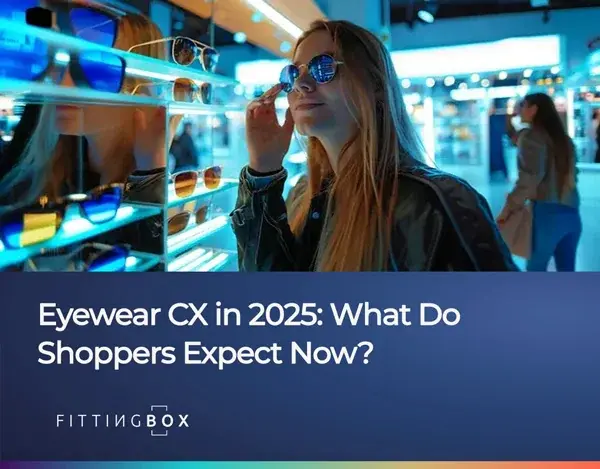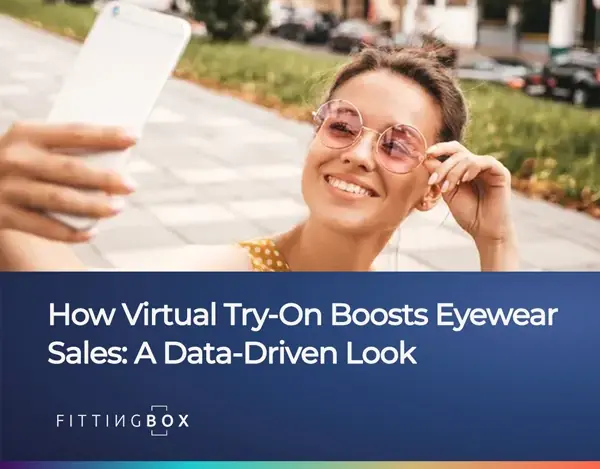
Why Mobile-First Eyewear Experiences Drive Conversions in 2025
Your customers are shopping for glasses on their phones right now. Mobile traffic accounts for over 65% of global ecommerce visits in 2025, and eyewear is no exception. As more users discover and purchase glasses through smartphones, offering a seamless mobile-first user experience (UX) is no longer optional. It is a key driver of conversions.
This article explores why a mobile-first design strategy is critical for eyewear ecommerce success. You'll learn about essential UX principles, discover how mobile-optimized virtual try-on enhances the shopping experience, and gain practical best practices to convert casual mobile browsers into satisfied customers.
🔑 Key Takeaways
-
A mobile-first user experience drives eyewear ecommerce conversions as mobile accounts for over 70% of sales.
-
Virtual try-on optimized for mobile increases eyewear conversion rates by up to 42%, improving user confidence.
-
Effective mobile UX involves prioritizing speed, intuitive navigation, touch-friendly design, and seamless checkout.
-
Enhancing mobile experiences significantly reduces returns and boosts average session durations, creating satisfied customers.

The Rise of Mobile Shopping in Eyewear
Mobile shopping has become standard practice across many sectors, and the eyewear industry is no exception. In 2025, mobile commerce (m-commerce) represents over 70% of total ecommerce sales worldwide, with eyewear brands reflecting a similar trend.
Recent studies indicate that 68% of online eyewear shoppers use smartphones at some stage of their purchasing journey. Several key factors contribute to this growth:
- Convenience: Consumers frequently browse eyewear options on mobile devices during commutes, breaks, or leisure moments at home.
- Social Media Influence: Platforms such as Instagram, TikTok, and Pinterest heavily inspire eyewear purchases, and mobile is the primary access channel.
- Advances in Mobile Technology: The rise of 5G networks, enhanced smartphone cameras, and improved screens facilitate richer experiences like virtual try-on directly from phones.
Specific mobile shopping behaviors in the eyewear sector include:
- Initial Product Research: Consumers usually begin exploring styles and trends through mobile browsing.
- Virtual Try-On Expectations: Users increasingly anticipate trying glasses virtually via mobile devices before committing to a purchase.
- Omnichannel Integration: Mobile browsing often leads to in-store visits or desktop purchases, underscoring the importance of seamless cross-device experiences.
Eyewear retailers must prioritize mobile-first UX design to effectively engage today's mobile-centric consumers and enhance conversions.
Mobile-First UX: Key Principles for Eyewear Ecommerce
Adopting a mobile-first UX in eyewear ecommerce involves more than just responsive design. It requires understanding and meeting the unique expectations and behaviors of mobile users. Here are key principles to consider:
Prioritize Speed and Performance
Mobile shoppers demand instant loading times. Even a one-second delay in page load can decrease conversions by up to 20%. Given the importance of visuals and interactive features like virtual try-on, optimizing performance is critical. Essential steps include:
- Compressing images and using modern image formats (WebP).
- Implementing lazy loading for off-screen elements.
- Minimizing heavy scripts and plugins.
Simplify Navigation and Product Discovery
Effective navigation on small screens ensures customers quickly find their desired eyewear. Mobile navigation should include:
- Clearly categorized sticky menus (e.g., men's, women's, sunglasses, prescription glasses).
- Intuitive, visual search with autocomplete suggestions.
- User-friendly filters designed for touch interactions.
Design for Touch Interactions
Designing for touch is fundamental to a mobile-first experience. To ensure user-friendly interaction, consider the following best practices:
- Using large, easily tappable buttons (at least 48 pixels tall).
- Spacing interactive elements to avoid accidental taps.
- Replacing hover effects with clear visual feedback for touch interactions.
Enhance Virtual Try-On for Mobile Users
Virtual try-on is indispensable in modern eyewear ecommerce. Ensure your mobile virtual fitting tool:
- Provides fast, seamless camera access.
- Clearly guides first-time users.
- Maintains compatibility across major operating systems (iOS and Android).
Implementing these UX principles helps eyewear retailers significantly enhance user engagement and encourage conversions on mobile devices.
How Mobile-Optimized Virtual Try-On Boosts Conversions
Mobile-optimized virtual try-on has become a powerful tool in eyewear ecommerce, helping consumers gain confidence in their purchases. A smooth, engaging virtual fitting experience directly accessible on smartphones significantly improves customer engagement and increases sales conversions.
Impact of Mobile Virtual Try-On
Data shows that implementing a mobile-optimized virtual try-on can boost eyewear conversion rates by up to 42%. Additionally, shoppers who interact with virtual fitting experiences typically:
- Spend 2.5 times longer browsing on the site.
- View up to 3 times more products.
- Are 30% more likely to complete a purchase.
These outcomes are due to the inherent advantages of mobile virtual try-on:
- Instant Convenience: Users easily activate virtual try-on through their smartphone’s camera.
- Social Sharing Capabilities: Smartphones simplify sharing try-on images with friends or social media followers, influencing purchase decisions.
- Reduced Purchase Hesitation: Seeing frames virtually on their face significantly increases consumer confidence.
Example of Mobile Virtual Try-On Success
A prominent European eyewear retailer recently implemented a fully mobile-optimized virtual try-on solution. Within three months, the retailer achieved significant improvements:
| Metric | Before Virtual Try-On | After Mobile Optimization |
|---|---|---|
| Conversion Rate | 2.1% | 3.4% |
| Average Session Duration | 3 min 20 sec | 7 min 15 sec |
| Return Rate | 12% | 8% |
This example demonstrates how optimizing virtual try-on for mobile not only enhances conversions but also strengthens customer satisfaction and reduces product returns.
Features of Effective Mobile Virtual Try-On Experiences
To replicate this success, focus on delivering:
- Quick startup time for virtual try-on (ideally under two seconds).
- Smooth, real-time rendering through the user's camera.
- Easy onboarding and accessibility with minimal clicks.
- Reliable performance across all popular mobile devices and browsers.
Best Practices to Implement a Mobile-First Eyewear Experience
Implementing a true mobile-first UX for your eyewear store involves more than simply adjusting to smaller screens. Each element of the shopping journey must strategically enhance mobile interactions, engagement, and sales conversions. Here are practical best practices to follow:
Optimize Visual Content for Mobile Devices
Visuals are fundamental in eyewear ecommerce. However, they must be adapted for mobile viewing:
- Use high-quality yet lightweight images for quick loading.
- Ensure interactive product images (zoom, swipe) are optimized for touchscreen devices.
- Enable full-screen viewing to provide detailed frame insights.
Create an Intuitive User Journey
A clearly defined mobile navigation flow encourages users to seamlessly progress from browsing to purchasing:
- Simplify menu categories to improve clarity and ease of use.
- Highlight popular and featured eyewear products prominently on the homepage.
- Implement sticky add-to-cart buttons for quick purchasing.
- Facilitate easy navigation between related products, frame colors, and lens options.
Integrate Virtual Try-On Effortlessly
Mobile virtual fitting tools should feel like a natural extension of the shopping experience:
- Prominently position the “Try On” button on every product page.
- Offer virtual fitting access without requiring app downloads or account sign-ins.
- Clearly present actionable next steps after trying on products (add to cart, view similar styles).
Prioritize Performance and Speed
Consistent mobile performance directly impacts both user satisfaction and search visibility:
- Regularly test site speed with tools like Google Lighthouse.
- Maintain a mobile page speed score of 90 or above.
- Continuously optimize and monitor loading speeds to ensure the best user experience.

Simplify the Mobile Checkout Process
A straightforward checkout experience is crucial to preventing cart abandonment:
- Implement single-page or streamlined checkout processes.
- Support autofill and mobile payment solutions like Apple Pay or Google Pay.
- Offer guest checkout options for faster conversions.
Applying these best practices effectively positions your eyewear ecommerce for success with today's mobile-driven consumers.
Conclusion
Adopting a mobile-first UX is essential for eyewear retailers seeking sustained growth in today's smartphone-dominated ecommerce environment. By emphasizing performance, intuitive design, seamless integration of virtual try-on, and simplified mobile checkout, you can convert mobile traffic into loyal, satisfied customers.
Investing in technologies optimized for mobile experiences not only enhances customer engagement but also produces measurable business outcomes, from higher conversion rates to reduced returns. The eyewear brands that prioritize mobile-first strategies will be best positioned to capture the expanding mobile shopping market.
LET'S TALK
Request a demo, a quote or set up an appointment with one of our sales representatives.
CONTACT USUseful Links
Corporate
© FITTINGBOX 2025 • Terms of use • Privacy & Legal


